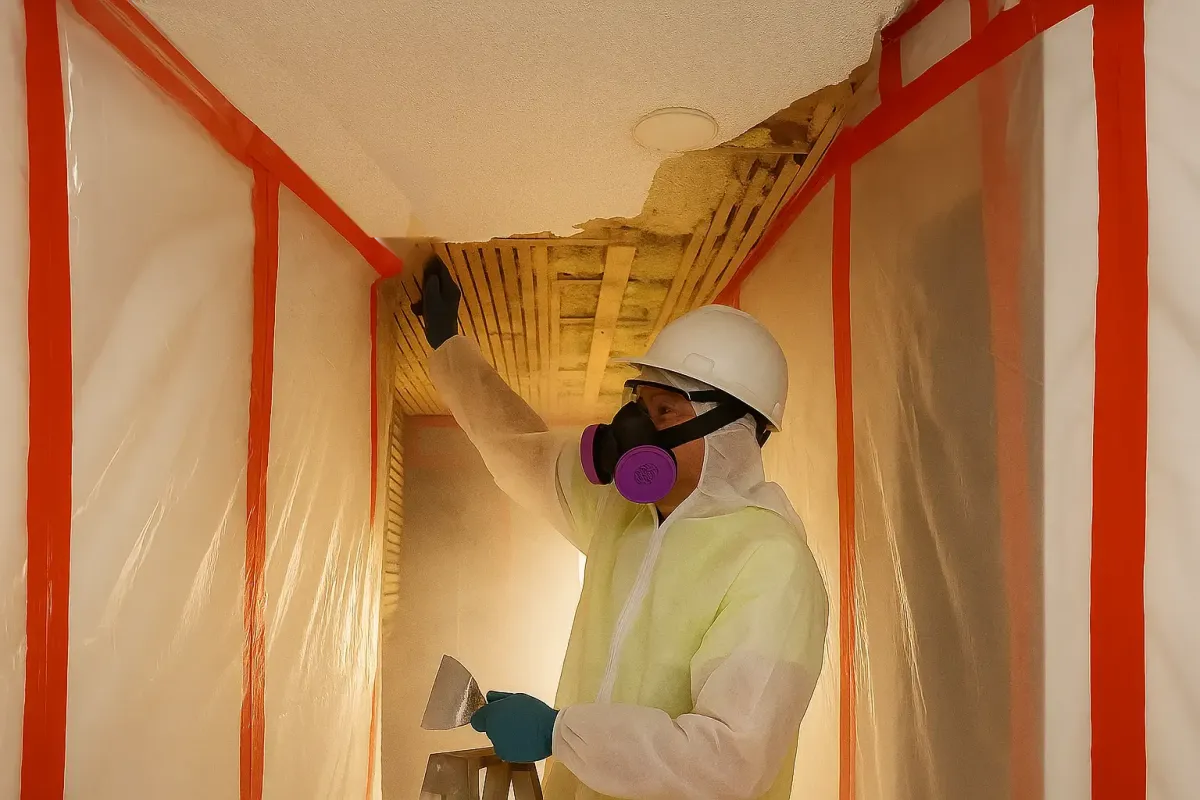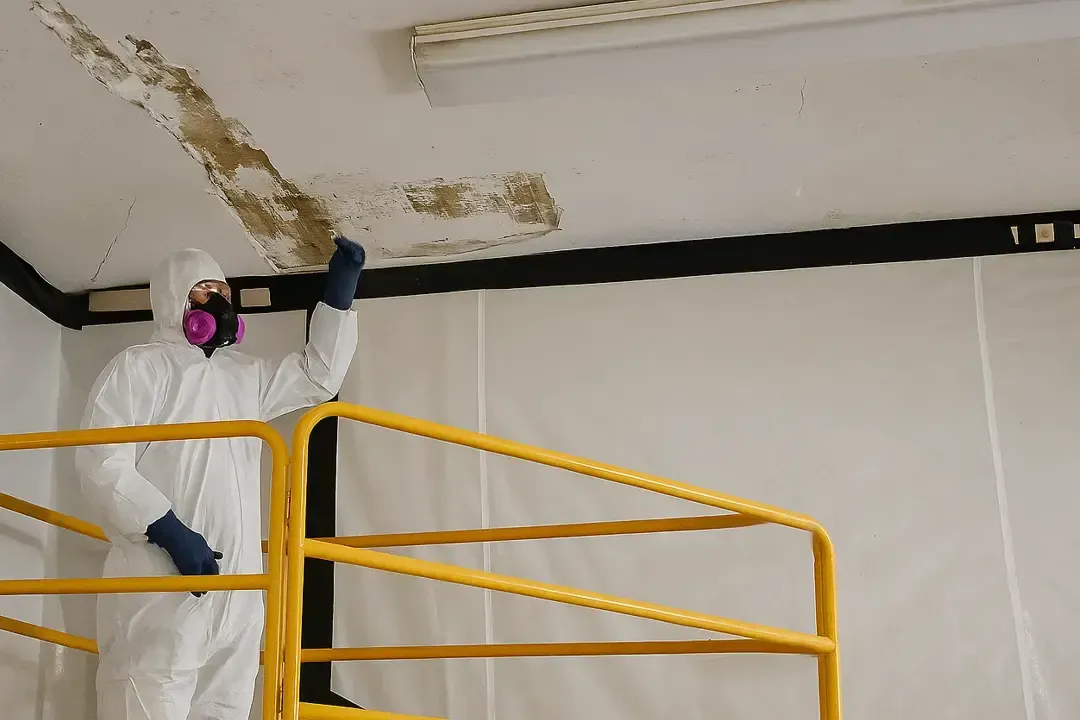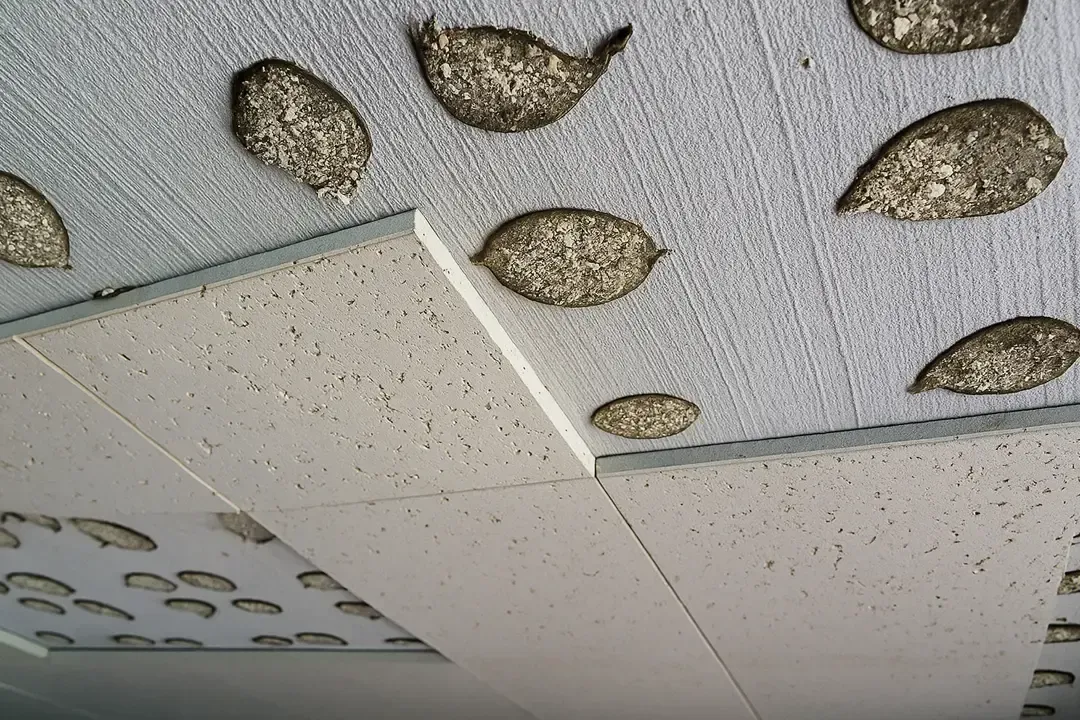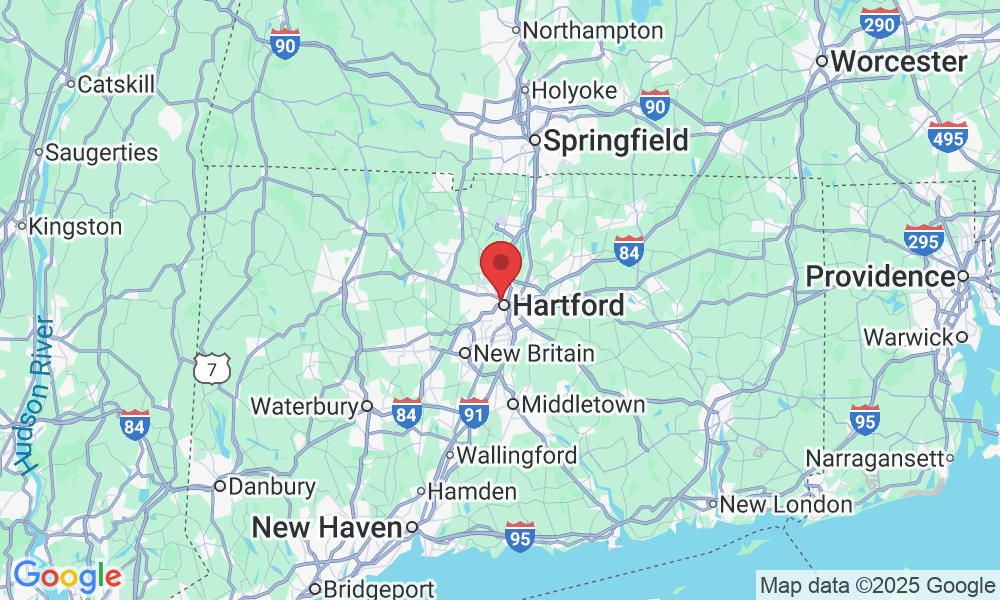Asbestos "Popcorn" & Acoustic Ceiling Removal in CT
Asbestos "Popcorn" & Acoustic Ceiling Removal in CT
That rough, textured "popcorn" ceiling was a popular aesthetic for decades, but many applications before the 1980s contained asbestos to add texture and fire resistance. Today, it's a source of concern for homeowners looking to modernize or repair their ceilings. Even a small scrape or water leak can release hazardous fibers into your living space. Alberca Construction provides a clean, safe, and complete removal service.
Common Types of Asbestos-Containing Ceilings
1. Sprayed-On "Popcorn" Ceilings
This bumpy, cottage-cheese-like texture was sprayed on and often contained up to 10% asbestos. Its main danger is that it is highly "friable," meaning it can easily crumble into a fine, breathable dust with minimal contact.

2. Asbestos Acoustic Ceiling Tiles
Common in basements, commercial buildings, and schools, these square or rectangular tiles (often 12x12 or 24x24 inches) were used for their sound-dampening and fire-resistant qualities. Asbestos was incorporated into the fibers of the tiles themselves.

1. Sprayed-On "Popcorn" Ceilings
This bumpy, cottage-cheese-like texture was sprayed on and often contained up to 10% asbestos. Its main danger is that it is highly "friable," meaning it can easily crumble into a fine, breathable dust with minimal contact.

2. Asbestos Acoustic Ceiling Tiles
Common in basements, commercial buildings, and schools, these square or rectangular tiles (often 12x12 or 24x24 inches) were used for their sound-dampening and fire-resistant qualities. Asbestos was incorporated into the fibers of the tiles themselves.


Disturbing asbestos-containing ceilings, whether through renovation, water damage, or simply old age, can lead to the release of microscopic fibers into the air. These fibers can circulate throughout your property's HVAC system, contaminating other areas and posing serious long-term health risks to occupants.
Our Safe & Meticulous Ceiling Removal Process
Our Safe & Meticulous Ceiling Removal Process
Removing ceiling asbestos requires a top-down approach with extreme care to protect everything below.
1. Empty and Seal the Room
First, the room is completely emptied of all furniture and belongings. We then seal all surfaces—walls and floors—with a double layer of polyethylene sheeting. The HVAC system vents are sealed off to prevent any cross-contamination.
2. Wet Removal Method
To minimize dust, we thoroughly wet the ceiling texture with a water-based solution containing a surfactant. This soaks the material, turning it into a paste-like substance that is far less likely to release airborne fibers when scraped.
3. Careful Scraping and Containment
Our team carefully scrapes the wetted texture, which falls directly onto the protective plastic sheeting below. All contaminated material and plastic is then immediately rolled up and securely bagged in approved asbestos disposal containers.
4. HEPA Vacuum Cleanup & Final Wipe-Down
After all the material is removed, we conduct a detailed cleanup. This includes HEPA vacuuming all surfaces within the containment zone and a final wet-wiping to ensure the room is left completely decontaminated and safe.
1. Empty and Seal the Room
First, the room is completely emptied of all furniture and belongings. We then seal all surfaces—walls and floors—with a double layer of polyethylene sheeting. The HVAC system vents are sealed off to prevent any cross-contamination.
2. Wet Removal Method
To minimize dust, we thoroughly wet the ceiling texture with a water-based solution containing a surfactant. This soaks the material, turning it into a paste-like substance that is far less likely to release airborne fibers when scraped.
3. Careful Scraping and Containment
Our team carefully scrapes the wetted texture, which falls directly onto the protective plastic sheeting below. All contaminated material and plastic is then immediately rolled up and securely bagged in approved asbestos disposal containers.
4. HEPA Vacuum Cleanup & Final Wipe-Down
After all the material is removed, we conduct a detailed cleanup. This includes HEPA vacuuming all surfaces within the containment zone and a final wet-wiping to ensure the room is left completely decontaminated and safe.
Ready for Smooth, Modern, and Safe Ceilings?
Let us help you remove that outdated and potentially hazardous popcorn ceiling the right way. Contact us for a professional assessment and a free, no-obligation estimate.
Ready for Smooth, Modern, and Safe Ceilings?
Let us help you remove that outdated and potentially hazardous popcorn ceiling the right way. Contact us for a professional assessment and a free, no-obligation estimate.
Frequently Asked Question
What exactly is asbestos and why is it dangerous?
Asbestos is a naturally occurring mineral composed of microscopic fibers. Due to its heat resistance and durability, it was heavily used in building materials until the 1980s. It is dangerous because, if disturbed, it releases these fibers into the air. When inhaled, they can become lodged in the lungs and, over time, cause serious illnesses like asbestosis and cancer.
How do I know if I have asbestos in my home?
It's impossible to know just by looking. Generally, if your home was built before 1985, there is a chance it contains asbestos in materials like attic insulation (vermiculite), floor tiles, popcorn ceilings, exterior siding, or pipe wrap. The only way to be 100% certain is through laboratory testing.
Should I take a sample myself to get it tested?
No, never. Taking a sample yourself without the proper equipment and protocols can be very dangerous, as it can release a high concentration of fibers in a small area. You should always contact a certified professional for inspection and sampling. We coordinate this service with independent firms to ensure your safety. (You can read more on our [Asbestos Inspection & Testing] page).
Is it safe to stay in my home during the asbestos removal process?
It depends on the scope and location of the project. For small, well-contained jobs, it may be possible to remain in the house. For larger projects, especially those in high-traffic areas or involving the HVAC system, we recommend arranging to be off the property. Your family's safety is our #1 priority, and we will always give you a clear and honest recommendation for your specific situation.
How long does an asbestos removal project take?
The duration varies depending on the size and complexity of the job. A small project in a basement might take 1-2 days. A full attic abatement could take 3-5 days or more. Your detailed estimate will include a projected timeline.
What happens to the asbestos after you remove it?
Asbestos is a regulated hazardous waste. All material is placed in sealed and labeled bags or containers according to EPA and CT DEEP regulations. It is then transported by licensed haulers to a specific landfill that is licensed to receive asbestos waste. We provide you with all disposal documentation for your records.
How much does asbestos removal cost?
The cost varies and depends on several factors: the amount of material to be removed, its location and accessibility, and the type of material (loose vermiculite is different from floor tiles). This is why we cannot give a price without seeing the site. What we do guarantee is a detailed, transparent estimate with no hidden costs.
Is the estimate free?
Yes, absolutely. Our initial site visit to assess the project and provide you with a detailed estimate is completely free and without obligation.
Are there any financial aid or rebate programs available?
Yes! The most notable case is the ZAI Trust, which can reimburse homeowners for a significant portion of the cost of vermiculite insulation removal. We are very familiar with this process and can guide you through it. (You can read more on our Rebates & Cost-Saving Programs page).
Are you licensed and insured in Connecticut?
Yes. Alberca Construction Company LLC holds all required licenses from the state of Connecticut for asbestos and hazardous material abatement. We also carry full general liability insurance and a specific pollution liability insurance policy for your complete protection and peace of mind. (You can see more on our Certifications page).
What areas of Connecticut do you serve?
We serve the entire state of Connecticut from our base in Hartford.
How far in advance do I need to schedule my project?
We try to be as flexible as possible. Generally, once an estimate is approved, we can schedule work to begin within 1-2 weeks, depending on our current workload. For emergency situations, we will do everything we can to assist you sooner.
Get In Touch
Email: [email protected]
Phone: (860) 206-7176
Address : 180 Walnut St, Hartford Connecticut 06120
Assistance Hours :
Mon – Sat 7:00am - 5:30pm
Sunday – CLOSED


